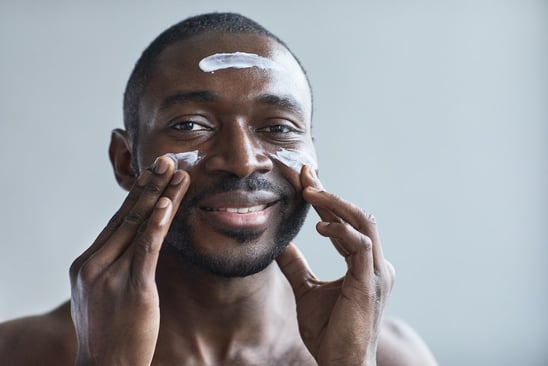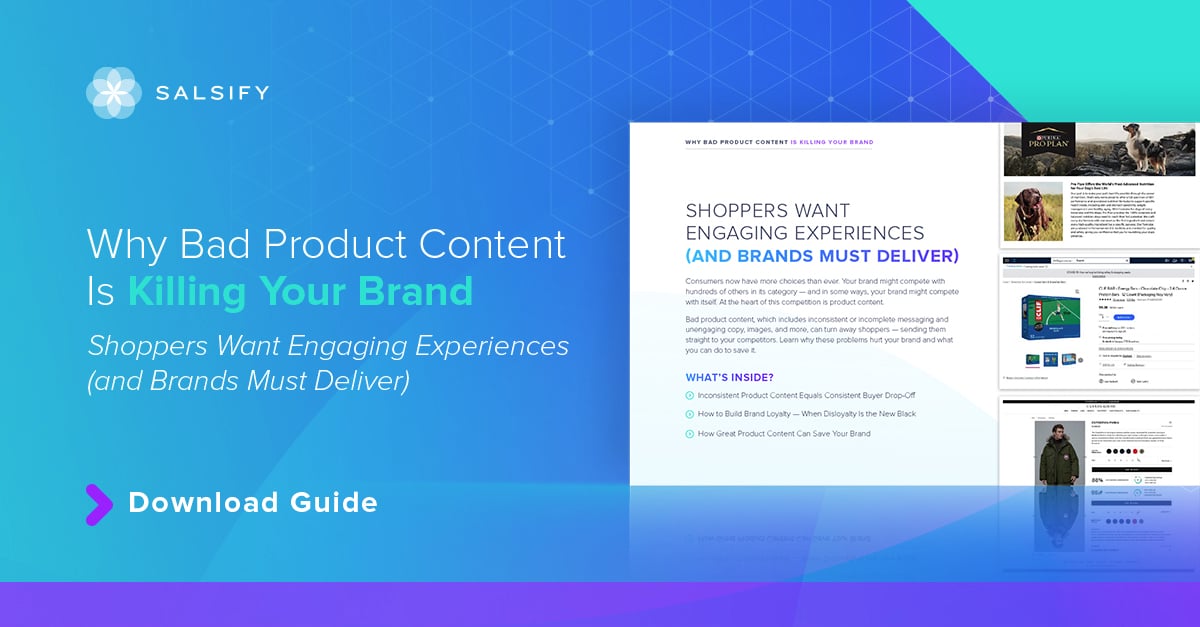

Why Bad Product Content is Killing Your Brand
Download our guide to learn more about the biggest product page mistakes that turn off shoppers.
DOWNLOAD GUIDEPIM
Manage all product content in one central system of record.
Activation
Easily syndicate product content to every consumer touch point.
Enhanced Content
Enrich product pages with below-the-fold content and rich media.
Catalog Sites
Share customized, up-to-date digital product catalogs.
Automation
Enhance collaboration with Salsify’s automated workflow engine.
Activation Insights
Continuously optimize your organization’s product content syndication.
GDSN Data Pool
Synchronize standard supply chain, marketing, and ecommerce attributes globally.
PXM Platform, Integrations, and APIs
Integrate the PXM platform with the rest of your enterprise systems architecture.
Supplier Onboarding
Accelerate supplier onboarding while ensuring your schema requirements are met.
Product Listing
Sell products faster with Product Listing.
Content Enrichment
Increase online conversions with Content Enrichment.
Automation
Save time and increase operational efficiency with retail automation.
SXM Platform, Integrations, and APIs
Integrate the SXM platform with the rest of your enterprise systems architecture.
Activation Network
Automate how you exchange product content data to the digital shelf.
Enhanced Content Network
Turn product pages into product experiences with Enhanced Content.
Ecommerce Platform Integrations
Create winning product experiences on owned sites with powerful ecommerce software.
GDSN Data Pool
Synchronize standard supply chain, marketing, and ecommerce attributes globally.
Open Catalog
Connect to the digital shelf faster with an open, standardized, and free product catalog.
Resources
Resource Library
Explore our ecommerce resources to get everything you need to win on the digital shelf.
Blog
Read our blog to get actionable insights for navigating changing markets and industry demands.
Webinars
Watch our on-demand ecommerce webinars to gain expert advice and tips from our community of industry leaders.
Engineering Blog
Explore our engineering blog to get developer resources, insights, and tips.
Events
Register for our upcoming in-person and virtual events to connect with other industry insiders.
Knowledge Base
Investigate our knowledge base to build your Salsify skills and understanding.
Product Updates
Explore the latest news and updates for Salsify products.
API
Examine our comprehensive API and webhook guides to start working with Salsify quickly.

Download Salsify's report to get insights into the latest trends and consumer behaviors.

Stagnation is a concern for any legacy brand, especially in the beauty industry where successful digitally native vertical brands (DNVBs) — like Glossier, Prose, and Thrive Causemetics – have established stiff competition.
Born and raised on the internet, DNVBs focus intently on their relationships with customers. At the center of their strategies are nimble and ever-evolving direct-to-consumer (D2C) business models, captivating brand stories and product content, near-constant social media dialogue, and relatable, user-powered product experiences.
These companies have rapidly amassed cult followings and big annual revenues as a result.
But legacy beauty and health brands can compete effectively by noting and implementing what these companies are doing well — brand storytelling, immersive customer experiences, and innovative uses of personalization.
Here are five tips for legacy beauty and health brands looking to compete with these newcomers.
Beauty brand Glossier, which began as a blog in 2014, rose to "unicorn" status — a startup company valued at over $1 billion — using YouTube tutorials and Instagram influencers.
The secret to success for the brand is no secret at all: It boasts reliable products, and users are encouraged to post product tests and reviews on social channels. This user-generated content (UGC) eliminates the transactional feeling of shopping and instead gives consumers a more emotional connection with the brand.
It also helps build brand trust, which has many benefits, including brand loyalty. This strong social connection to customers also creates an instant focus group for the brand. When a DNVB wants to know what consumers want from its next product offering, its team can simply ask its loyal social media followers.
Artificial intelligence (AI) technology — when combined with approachable content — is another way to build trust with consumers. One year after its launch, personalized shampoo brand Prose was on track to reach $1 million in monthly revenue. As one of the first "technology-powered beauty companies," the brand relies on AI technology to do the heavy lifting of order data collection on its website.
Such mechanical interaction can be viewed with skepticism by shoppers — as AI can sometimes feel cold and corporate. But for Prose, the carefully crafted messaging and experience help users feel like they're speaking with a stylist at a hair salon.
This conversational tone puts the consumer at ease while taking a well-explained and thorough online quiz to gather details about hair type, age, products and treatments used, and environmental factors. Using these answers, Prose's AI technology then generates an individualized formula by combining 76 natural ingredients — and has over 50 billion possible combinations.
By embracing new innovations and technology, brands can help drive engagement and capitalize on personalization opportunities — an aspect of online shopping with increasing demand.
Health and beauty care are intimate and personal by nature. Skin type, hair texture, pigmentation, and other attributes all vary from one individual to the next. It's a wonder beauty brands haven't prioritized personalization more.
The key element: From start to finish, every Prose interaction feels unique, one-of-a-kind, and decadently indulgent — all features legacy brands should include in their online product experiences. After the shopping is done, and as another personalizing touch, consumers can also opt to have their specially formulated products delivered on a subscription basis.
Personalization and subscription services are excellent opportunities for legacy brands to experiment. Not only does personalization help shoppers feel more connected to the products, but it could also help your brand evolve alongside changing health and beauty trends.
Subscription services are also excellent opportunities for bundling products and introducing customers to other products within your lines they may not have considered otherwise.
Coupling philanthropy with high-performing vegan makeup and skincare, Thrive Causemetics has quickly and quietly garnered a dedicated following of conscious consumers.
Living up to its motto, "Luxury Beauty That Gives Back," Thrive Causemetics had donated makeup products and funding to a number of non-profits. The brand highlights its philanthropic mission across its online presence, and many customers purchase from the brand because its values align with their own.
Customers are increasingly more likely to buy products from brands that align with their values, and by highlighting brand values within product content, brands can build stronger connections with their customers.
For DNVBs, content is their brand's digital packaging. It's about connectivity as much as it's about selling. Shoppers increasingly demand more product content before making final purchasing decisions, as problems with product content lead shoppers to abandon a product purchase.
Brands must find new ways to engage shoppers online using engaging content experiences.
Enhanced content includes everything from comparison charts highlighting lipstick shades or skincare lines and videos showing popular beauty bloggers using the products to illustrations that highlight how to apply the product. This content helps shoppers gain a better understanding of the brand and products and helps them make final buying decisions.
This content is especially crucial for beauty and health brands, as many shoppers seeking these products prefer in-store experiences. Enhanced content is one way brands can help boost conversion online, as it's been shown to increase conversion by up to 15% across most categories, according to Salsify internal data.
To compete with DNVBs, well-established brands must have clear and consistent content. Wherever products are shopped — or however they are discovered — the experience must feel rich and engaging.

Download our guide to learn more about the biggest product page mistakes that turn off shoppers.
DOWNLOAD GUIDESalsify drives results for customers worldwide, empowering them to win on the digital shelf.
Standing out on the digital shelf starts with access to the latest industry content. Subscribe to Below the Fold, our monthly content newsletter, and join other commerce leaders.